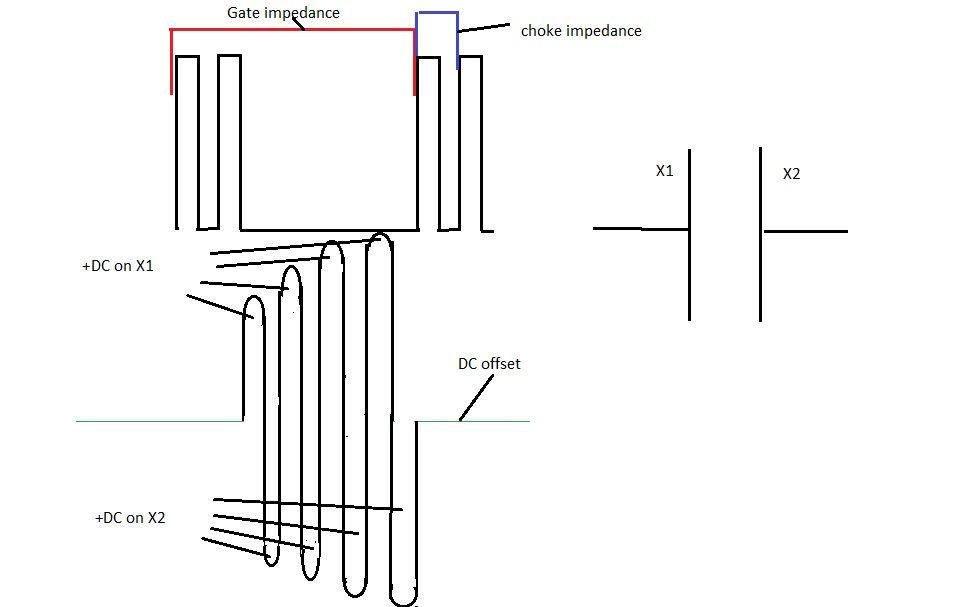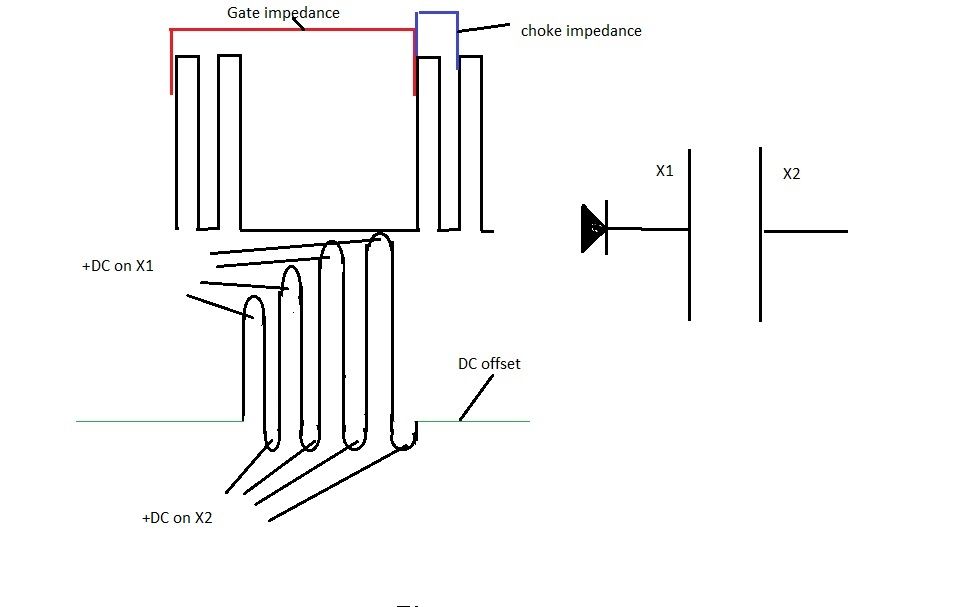Doing this thread to try to comprehend what is happening to the DC voltage we create on the fuel cell at AC resonance. Recently i've learned quite a bit about Stan's circuitry by seperating the primary and secondary from the chokes. By doing this it allows us to understand what happens in the circuitry much better and where the voltage is sitting together with a better understanding of where the voltage goes.
So we know that there is an LC circuit taking place between the cell and the chokes and here is a picture of it from my recent experiments.

So what do we know about this LC network between the chokes and the cell? Well, even though a diode exists we know that the resonance is actually AC resonance and it rides the series diode and we know that the DC responds to the AC signal because without it then the DC simply fails to materialise and we need the DC for the cell to perform work.
First thing to understand about LC networks: If you create an LC network between one inductor and one capacitor the reactance is equal and cancelling so that no AC or DC bias exists and that is a fact of life. It happens because each 180 degree phase of an AC signal is equal by definition because the inductor behaves exactly the same in one direction as it does in the other. Ed Mitchell has been commenting recently on my Youtube video's and has mentioned that the reactance of the cell is different from the chokes and it is this fact that creates the DC bias on the cell. That is impossible and i'll tell you why:
Any LC resonance at AC decides its own self resonant frequency, we as experimenters cannot decide such a frequency in any way shape or form, it is the reactance of the capacitor and the reactance of the inductor that chose where the frequency sits and that frequency is always equal reactance. If you had a notion that you wanted the cell to be more reactive than the chokes then that is impossible because the very nature of LC resonance equals ALL reactances to a level playing field. There can be no bias anywhere in this scenario.
So lets move on and look at this following drawing:

In the drawing you will see a square wave pulse at the top with two frequencies, the first frequency is the gate frequency which is driving a resistor or a spark gap, the second frequency is an higher frequency which is driving our chokes and cell. The high frequency signal is being choked from the low frequency signal at an high impedance. The reason it is high impedance is because the resistance across the water gap in the fuel cell is very high at that particular frequency.
Now, the AC resonance drawed below the square wave which is responding to the square wave pings taking place is LC resonance between the chokes and the water fuel cell and it ignores any diode in the series circuit and as with all capacitors a DC value is placed on X1 cap plate BUT the equal positive charge is also placed on the X2 plate when the AC signal passes through the other 180 degrees of it's signal. What this means is besides the equal AC reactance taking place between the cell and the chokes there is also cancellation of DC voltage taking place on the cell.
Now look at this drawing:

You will notice that through the first 180 degrees of AC resonance between the chokes and the cell a +DC value has built up on X1 capacitor plate but through the next 180 degrees of the AC phase, the +DC value is missing from X2 cap plate. HOW DOES THIS HAPPEN?
We created a DC bias from an AC signal did we not? The reason it happens is in fact very simple, L1 which created the initial +DC voltage on X1 is of higher reactance than L2 and you have to look on a scope at low voltage to understand this. When the initial AC wave form hits resonance and an LC network forms between the chokes and the cell it is NOT a mean everage of L1+L2 and the cell, The first 180 degrees of the AC signal uses the higher reactance of L1 to place +DC on X1 cap plate and L2 is trailing. On the opposite 180 degrees of the AC signal, L2 has less reactance with the cell and L1 is trailing. This difference in reactance at AC is what causes a DC bias on X1 capacitor plate. The diode in the series circuit stops the DC bias on X1 from escaping back into the system.
The system is step charging the DC bias because of a difference in reactance when L1 is at the leading edge and when L2 is at the leading edge of each respective 180 degree phase. Why does this happen and why are both 180 degree signals NOT a mean average of both L1 and L2?
It is because the cell's reactance is being tricked, the cell thinks there is just one inductor and it is creating an LC network with one inductor, it resonates with L1 in 180 degree's of the phase then resonates with L2 in the other 180 degrees thinking it's the same inductor at the same reactance but L2 has less reactance and so the bias is left behind.
So we know that there is an LC circuit taking place between the cell and the chokes and here is a picture of it from my recent experiments.

So what do we know about this LC network between the chokes and the cell? Well, even though a diode exists we know that the resonance is actually AC resonance and it rides the series diode and we know that the DC responds to the AC signal because without it then the DC simply fails to materialise and we need the DC for the cell to perform work.
First thing to understand about LC networks: If you create an LC network between one inductor and one capacitor the reactance is equal and cancelling so that no AC or DC bias exists and that is a fact of life. It happens because each 180 degree phase of an AC signal is equal by definition because the inductor behaves exactly the same in one direction as it does in the other. Ed Mitchell has been commenting recently on my Youtube video's and has mentioned that the reactance of the cell is different from the chokes and it is this fact that creates the DC bias on the cell. That is impossible and i'll tell you why:
Any LC resonance at AC decides its own self resonant frequency, we as experimenters cannot decide such a frequency in any way shape or form, it is the reactance of the capacitor and the reactance of the inductor that chose where the frequency sits and that frequency is always equal reactance. If you had a notion that you wanted the cell to be more reactive than the chokes then that is impossible because the very nature of LC resonance equals ALL reactances to a level playing field. There can be no bias anywhere in this scenario.
So lets move on and look at this following drawing:

In the drawing you will see a square wave pulse at the top with two frequencies, the first frequency is the gate frequency which is driving a resistor or a spark gap, the second frequency is an higher frequency which is driving our chokes and cell. The high frequency signal is being choked from the low frequency signal at an high impedance. The reason it is high impedance is because the resistance across the water gap in the fuel cell is very high at that particular frequency.
Now, the AC resonance drawed below the square wave which is responding to the square wave pings taking place is LC resonance between the chokes and the water fuel cell and it ignores any diode in the series circuit and as with all capacitors a DC value is placed on X1 cap plate BUT the equal positive charge is also placed on the X2 plate when the AC signal passes through the other 180 degrees of it's signal. What this means is besides the equal AC reactance taking place between the cell and the chokes there is also cancellation of DC voltage taking place on the cell.
Now look at this drawing:

You will notice that through the first 180 degrees of AC resonance between the chokes and the cell a +DC value has built up on X1 capacitor plate but through the next 180 degrees of the AC phase, the +DC value is missing from X2 cap plate. HOW DOES THIS HAPPEN?
We created a DC bias from an AC signal did we not? The reason it happens is in fact very simple, L1 which created the initial +DC voltage on X1 is of higher reactance than L2 and you have to look on a scope at low voltage to understand this. When the initial AC wave form hits resonance and an LC network forms between the chokes and the cell it is NOT a mean everage of L1+L2 and the cell, The first 180 degrees of the AC signal uses the higher reactance of L1 to place +DC on X1 cap plate and L2 is trailing. On the opposite 180 degrees of the AC signal, L2 has less reactance with the cell and L1 is trailing. This difference in reactance at AC is what causes a DC bias on X1 capacitor plate. The diode in the series circuit stops the DC bias on X1 from escaping back into the system.
The system is step charging the DC bias because of a difference in reactance when L1 is at the leading edge and when L2 is at the leading edge of each respective 180 degree phase. Why does this happen and why are both 180 degree signals NOT a mean average of both L1 and L2?
It is because the cell's reactance is being tricked, the cell thinks there is just one inductor and it is creating an LC network with one inductor, it resonates with L1 in 180 degree's of the phase then resonates with L2 in the other 180 degrees thinking it's the same inductor at the same reactance but L2 has less reactance and so the bias is left behind.